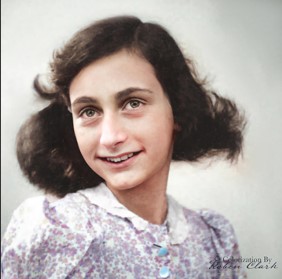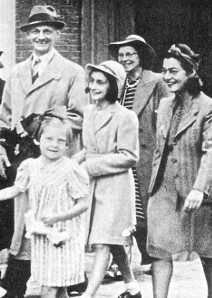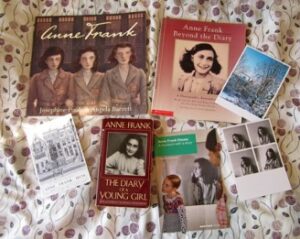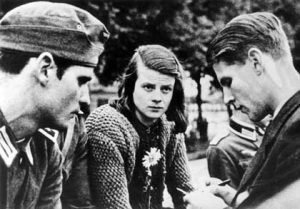The stories we write live on forever. Diaries are often something most precious to us, holding secrets of our truth and emotion. The blank pages call out to unwind and let our imagination run free; it’s a state of vulnerability. The combination of hope and fear were the two most expressed emotions of Anne Frank’s writing throughout her time in hiding. Each thought, experience, and feeling conveyed the challenging circumstances she faced. Having been restrained and limited to freedom during her hideout in the Secret Annex, Anne wrote about the two years she spent hiding from the Nazi occupation in Amsterdam as a way to cope with the fear of discovery.1 Anne’s perspective of her time in hiding inspired her to want to become a published writer or journalist. However, she never imagined that what was once her diary would soon become a war document recording one of the most traumatizing, catastrophic, and memorable times in history.

Anne Frank was among one of the six million European Jewish people killed during the Holocaust and one of the most famous historical and touching voices of World War Two. In the early morning of June 12, 1929, Edith Hollander Frank gave birth to her second child, a beautiful baby girl named Anne Frank in Frankfurt, Germany. Edith Frank was a carefree and adventurous Jewish woman who inherited wealth from her parents’ business while her husband, Otto Frank, was a German-Jewish-born merchant, who left his family to serve as a lieutenant during World War I. The Franks were known to be a typical upper-middle-class German-Jewish family living on the outskirts of Frankfurt.2 Then, in 1933, things in Germany began to worsen for Jews. With Adolf Hitler embarking on a new position, Chancellor of Germany as the leader of the Nazis party, the discrimination and hatred towards Jewish people intensified. Jews were forced to follow rigorous instructions that severely restricted their freedoms. One of the prime examples was the requirement of Jews to wear yellow stars of David and special clothing in order to be easily identified for the population track.3 Because of this, the Frank family moved to Amsterdam in 1934 to establish Otto Frank’s small trade business and away from the rising antisemitism in Germany. Although Anne was only four years old when she moved, she quickly adapted to the community. Anne’s father had described her as very popular among her peers and had no trouble making friends due to her creative, kind, and adventurous personality. She loved reading magazines, playing board games, and riding her bike just like any other girl her age.4 Moreover, in 1939, a couple of years later, after the Frank family moved, Germany invaded Poland and the declaration of war from France and Great Britain sparked the start of World War Two 5

On Anne Frank’s thirteen birthday, she was gifted a red checkered journal, which she named “Kitty.” But unfortunately, a month later, the Nazis had begun deporting Jewish families from the Netherlands to Death camps in German-occupied Poland.6 On the gloomy morning of July 5, 1942, Anne Frank’s sister, Margot Frank received a call-up to relocate to a labor camp in Germany. Due to this report, the Frank family panicked, and out of fear went into hiding in a small attic apartment located in Prinsengracht, Amsterdam, behind the business of Otto Frank. Before Margot received her letter, Anne’s father decided to build the outline for the Secret Annex. The Secret Annex was a hidden section behind the Frank’s company that consisted of a revolving bookcase entrance with two top floors, an attic, and a loft.7 During hiding, the Frank family received help from six office staff who provided food, clothing, magazines, and books. In addition, another Jewish family, the Van Pels, joined the Frank family in hiding. Hermann Van Pel, Auguste Van Pel, and their son Peter decided to go into hiding when they discovered that Peter would also be called up to labor camps in Germany. After several months of both families hiding, a man named Fritz Pfeffer joined them.8 Everyone who was hiding in the Annex was not allowed to step foot outside or else it would be too dangerous, because of the high possibility of being discovered. Anne Frank started to face hardships and uncertainty over what would come, as her teenage years passed in the hidden walls of the annex. During Anne’s time in hiding, she grew extremely passionate about the idea of becoming an author. To cope with the stress of World War Two, she wrote countless journal entries that expressed her love for the world through her imagination and creativity. Anne wrote her day-to-day life in the annex, even random thoughts and occurrences that happened. As she continued to write, her perspective on life matured as she began to write more about her identity and belonging in the world.
Anne Frank, through her diary, contributed various entries that depicted the harsh living conditions for many Jews. She also reflected on the understanding of humanity and her own identity of crushes, arguments with her mother, and resentment. Having grown up in the Secret Annex, Anne experienced a range of emotions, such as fear, frustration, and hope for the future. By reading the raw and unfiltered expressions of Anne’s emotions in writing, we can see a vulnerable perspective of her life.9 With what she was going through, Anne started to develop a sense of reality that if she were to die before the end of the war, then she had to make the most of her time. Despite the lack of privacy and the constant feeling of loneliness she felt during hiding, Anne continued to think positively and be happy. Her positive perspective gave her something to look forward to once she came out of hiding. In addition, she saw her time in the Secret Annex as an opportunity to self-reflect and improve herself as an individual.10 But the worst was yet to come.

After two years of hiding in the Secret Annex, Anne Frank and seven others had been discovered by the secret police known as the Gestapo. The discovery of the Secret Annex was due to an anonymous tipster who has yet to be named. At gunpoint, Anne Frank and the others in hiding were arrested and stripped of their valuables. Police emptied suitcases in hopes of discarding any evidence they could possibly find relating to their horrible actions. Anne’s diary was luckily scattered to the floor, while the police roamed the Annex. Later, after their arrest, Miep Gies, one of the helpers who hid Anne Frank and her family, found the diary and took it in hopes of giving it to Anne Frank after the war.11 Following the capture, everyone in hiding was sent to Camp Westerbork, a transit camp in the northeastern part of the Netherlands. The group of helpers and those hidden had been interrogated and questioned by the German police on whether they knew of any other hiding spots similar to the Secret Annex they were found in. After the group explained that they had lost contact with all their friends after staying in the annex for over two years, the police separated them from each other. The helpers were taken to the detention center at Amstelveenseweg, while the hidden, including Anne, were taken to the detention center in Weteringschans. The mass genocide of Jews continued to happen. With no remorse, the Nazis terrorized, deported, and killed Jewish citizens all over Europe.12 Concentration camps resembled the political and social injustice many innocent people faced during World War Two.

In an unexpected turn of events, Anne and her sister Margot were transported and killed in Bergen-Belsen concentration camp in 1945. In spite of the harsh conditions and cruel massacres that happened during World War Two, Anne Frank remained optimistic and hopeful of life. Her diary expresses how she was a resilient and extraordinary young woman who stood her ground. No matter the circumstance or how ridiculous it might have seemed to others, she never abandoned her belief in the goodness that people can have. Her last pieces of writing reflected the complex inner life and the different facets of her personality. She described herself as “a bundle of contradictions,” expressing how she was perceived by others versus how she truly felt inside. Anne wrote about her cheerful and carefree side, which enjoyed flirtations and jokes, but also revealed a deeper, more introspective side that longed for change and self-improvement.13 Being surrounded by darkness allowed her to truly find beauty in the small things.
On June 15, 1947, Otto Frank, Anne’s father, paid tribute to his daughter by publishing the first Dutch edition of her diary, known as The Diary of a Young Girl. However, the diary was originally rejected by publishers, because they claimed that people wouldn’t read a book that brought back memories of World War Two.14 When the book was published, the sales were amazing worldwide, except for in Germany. As the years went on, Anne Frank’s diary opened the eyes of many by capturing and recognizing the historical reality of six million Jews and the discrimination, hatred, and racism they faced during the Holocaust. With over 30 million publications translated into 70 different languages, Anne Frank continues to inspire people around the world to be hopeful and spread kindness to one another.15 Her work is truly remarkable for bringing awareness to the issues we still face today. As a society, we must look back on history and reflect on how we can change antisemitism through reading the beautiful words, thoughts, and life of Anne Frank when she was in hiding. She is an icon that will continue to spread awareness of the dangers of antisemitism, racism, and discrimination. With her personal testimony of life during World War Two, we can use it to challenge intolerance and discrimination.16 Like Anne Frank once said, “What is done cannot be undone, but at least you can keep it from happening again. I’ll take father as my example once again, and I will improve myself.”17 Therefore, there is no doubt that Anne Frank’s diary gives a voice to the millions of victims and is a reflection for future generations not to repeat history. Overall, the violence children faced during World War Two is still talked about in the twenty-first century, evoking empathy and understanding to foster a deeper compassion for human dignity.
- “The Authenticity of the Diary of Anne Frank,” Anne Frank Website, accessed May 5, 2024, https://www.annefrank.org/en/anne-frank/go-in-depth/authenticity-diary-anne-frank/. ↵
- Biography.com Editors and A&E Television Networks, “Anne Frank – Diary, Quotes & Family,” Biography, May 29, 2024, https://www.biography.com/authors-writers/anne-frank. ↵
- Louise Hawker, Genocide in Anne Frank’s The Diary of a Young Girl (Greenhaven Publishing LLC, 2011), 80. ↵
- Nancy D. Kersell, “Anne Frank,” in Salem Press Biographical Encyclopedia (Salem Press, January 1, 2023), 1. ↵
- John K. Roth, “Holocaust,” Salem Press Encyclopedia, 2023, Research Starters, accessed May 6, 2024, 1. ↵
- “1942 Going into Hiding | Anne Frank,” accessed May 2, 2024, https://www.annefrank.org/annes-wereld/en/anne-frank/1942-going-into-hiding. ↵
- “The Secret Annex | Prinsengracht 263 | Knowledge Base | Anne Frank House,” Anne Frank Stiching, accessed May 2, 2024, https://research.annefrank.org/en/locaties/a699d98a-eab0-4e27-a4a1-f2c76df56892/. ↵
- “The Main Characters,” Anne Frank Website, September 25, 2018, https://www.annefrank.org/en/anne-frank/main-characters/. ↵
- “Anne Frank – Diary, Biography & Facts,” HISTORY, July 1, 2020, https://www.history.com/topics/holocaust/anne-frank-1. ↵
- “Deep Survival: Anne Frank’s Extraordinary Act of Survival,” Adventure, June 8, 2009, https://www.nationalgeographic.com/adventure/article/deep-survival-lessons-from-anne-frank. ↵
- Luisse Carreos, The Diary of A Young Girl: Anne Frank, 2016, 3-4. ↵
- Louise Hawker and Gale (Firm), eds., Genocide in Anne Frank’s the Diary of a Young Girl, Social Issues in Literature (Detroit: Greenhaven Press, 2012). ↵
- History.com Editors and A&E Television Networks, “Anne Frank Writes Her Last Diary Entry | August 1, 1944,” HISTORY, June 21, 2019. ↵
- Alex Sagan, “An Optimistic Icon: Anne Frank’s Canonization in Postwar Culture,” German Politics & Society 13, no. 3 (36) (1995): 5. ↵
- Jennifer L. Foray, “The Nation Behind the Diary: Anne Frank and the Holocaust of the Dutch Jews,” The History Teacher 44, no. 3 (2011): 1. ↵
- Anne Frank Stichting. (2021). The Anne Frank House promotes tolerance on UNESCO International Day for Tolerance. Anne Frank House. Retrieved March 25, 2024, from https://www.annefrank.org/en/about-us/news-and-press/news/2021/11/16/international-day-for-tolerance/. ↵
- Anne Frank, The Diary of a Young Girl (Knopf Doubleday Publishing Group, 2010), 191. ↵



4 comments
Silvia Benavides
I too, believe it is a shame she never got to live long enough to see how influential and great her work is regarded as today. Her legacy will live on.
Gaitan Martinez
As the article said, Anne Frank wrote her diary not knowing how influential and inspiring her work would be later on, and it’s a shame that she never got to see that day. A factor that always intrigued me was how it was edited because it contained certain…sexual parts. After all, she was a girl growing into adulthood, but maybe those intimate parts are best left for her and her family.
Nicholas Pigott
Hi Nyleen! You have written a fantastic and inspiring article on one of the brave women we’ll learn about in a lifetime. I remember reading excerpts of Anne Frank’s diary in middle school and to this day, they still have not left me. You’re spot on that antisemitism must be combatted, and ensure a holocaust never happens again. We have this brave girl to thank for all the inspiration she’s given across the world.
Lauren Sahadi
This was a beautiful article on Anne Frank’s diary. It showed the resilience and hopes she had during her time in the Holocaust. This was truly a moving article that was so well written. You made the reader feel something and I was interested the whole time. This was a subject matter that I’ve seen a lot, but you made it stand out. Great job.